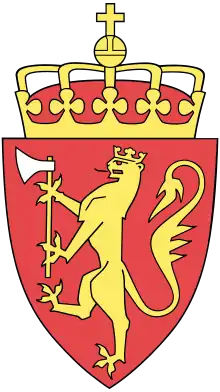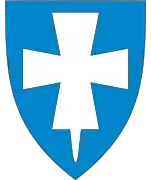Gjesdal
Gjesdal is a municipality in Rogaland county, Norway. It is located in the traditional district of Jæren. The administrative centre of the municipality is the village of Ålgård. Other villages in Gjesdal include Dirdal, Frafjord, Gilja, Gjesdal, and Oltedal. The municipality lies about 25 kilometres (16 mi) to the southwest of the city of Stavanger in southwestern Norway.[3]
Gjesdal kommune
Gjestal (historic) | |
|---|---|
.jpg.webp) View of the Gjesdal landscape | |
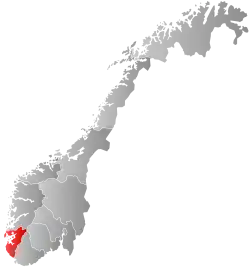 Rogaland within Norway | |
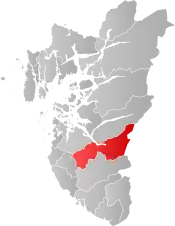 Gjesdal within Rogaland | |
| Coordinates: 58°46′55″N 06°00′31″E | |
| Country | Norway |
| County | Rogaland |
| District | Jæren |
| Established | 1 Jan 1838 |
| Administrative centre | Ålgård |
| Government | |
| • Mayor (2013) | Frode Fjeldsbø (Ap) |
| Area | |
| • Total | 617.98 km2 (238.60 sq mi) |
| • Land | 558.21 km2 (215.53 sq mi) |
| • Water | 59.77 km2 (23.08 sq mi) 9.7% |
| Area rank | 187 in Norway |
| Population (2020) | |
| • Total | 12,002 |
| • Rank | 95 in Norway |
| • Density | 21.5/km2 (56/sq mi) |
| • Change (10 years) | 17.6% |
| Demonym(s) | Gjesdalbu[1] |
| Time zone | UTC+01:00 (CET) |
| • Summer (DST) | UTC+02:00 (CEST) |
| ISO 3166 code | NO-1122 |
| Official language form | Neutral[2] |
| Website | gjesdal |
The European route E39 highway runs through the western side of the municipality. On the east side of the municipality, the Frafjord Tunnel connects the Frafjord valley with the rest of the municipality.
The 618-square-kilometre (239 sq mi) municipality is the 187th largest by area out of the 356 municipalities in Norway. Gjesdal is the 95th most populous municipality in Norway with a population of 12,002. The municipality's population density is 21.5 inhabitants per square kilometre (56/sq mi) and its population has increased by 17.6% over the previous 10-year period.[4][5]
General information
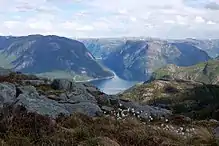

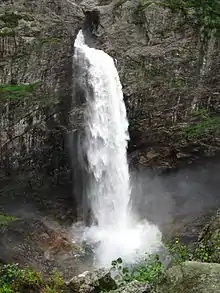
Name
The municipality (originally the parish) is named after the old Gjesdal farm (Old Norse: Gesdalir), since the first Gjesdal Church was built there. The first element is probably an old river name and the last element is the plural form of dalr which means "valley" or "dale".[6]
Before 1889, the name was written Gjæsdal, which is the Danish spelling. During the period from 1889-1917 it was spelled Gjesdal (Norwegian language version). Then starting in 1918, it was spelled Gjestal after the pronunciation of the local dialect (the d in dal is pronounced t because of the voiceless consonant s in front). In 1964, the spelling was changed back to the etymologically correct form of Gjesdal.[7]
Coat of arms
The coat of arms was granted on 15 March 1985. The arms show a white sheep's head on a blue background. The sheet was chosen as a symbol because sheep breeding and wool manufacturing have both been important throughout the history of Gjesdal. The wool industry was centered in the village of Ålgård where wool, textile, and clothing businesses have thrived.[8]
Churches
The Church of Norway has two parishes (sokn) within the municipality of Gjesdal. It is part of the Jæren prosti (deanery) in the Diocese of Stavanger.
| Parish (sokn) | Church name | Location of the church | Year built |
|---|---|---|---|
| Gjesdal | Dirdal Church | Dirdal | 1903 |
| Gjesdal Church | Gjesdal | 1848 | |
| Oltedal Church | Oltedal | 2002 | |
| Ålgård | Ålgård Church | Ålgård | 2015 |
| Old Ålgård Church | Ålgård | 1917 |
History
The parish of Gjæsdal was established as a municipality in 1838 (see formannskapsdistrikt law). It originally was much smaller than it is today, centered on the Gjesdalen valley in the western part of the present-day municipality. During the 1960s, there were many municipal mergers across Norway due to the work of the Schei Committee. On 1 January 1965 several areas were merged to form a much larger municipality of Gjesdal:[9]
- the original municipality of Gjesdal (population: 3,353)
- the Nedre Maudal area in Bjerkreim municipality (population: 40)
- the Oltesvik area along the Høgsfjorden in Høle municipality (population: 37)
- the parts of Forsand municipality south and east of the Frafjorden including Dirdal, Frafjord, Byrkjedal, Øvre Maudal, and Østabødal (population: 621)
On 1 January 1970, an unpopulated area of Time Municipality was transferred to Gjesdal. Then on 1 January 1989, another small, unpopulated area of Time was transferred to Gjesdal.[9]
Government
All municipalities in Norway, including Gjesdal, are responsible for primary education (through 10th grade), outpatient health services, senior citizen services, unemployment and other social services, zoning, economic development, and municipal roads. The municipality is governed by a municipal council of elected representatives, which in turn elect a mayor.[10] The municipality falls under the Jæren District Court and the Gulating Court of Appeal.
Municipal council
The municipal council (Kommunestyre) of Gjesdal is made up of 27 representatives that are elected to four year terms. Currently, the party breakdown is as follows:
| Party Name (in Norwegian) | Number of representatives | |
|---|---|---|
| Labour Party (Arbeiderpartiet) | 10 | |
| Progress Party (Fremskrittspartiet) | 4 | |
| Green Party (Miljøpartiet De Grønne) | 1 | |
| Conservative Party (Høyre) | 3 | |
| Christian Democratic Party (Kristelig Folkeparti) | 4 | |
| Centre Party (Senterpartiet) | 4 | |
| Socialist Left Party (Sosialistisk Venstreparti) | 1 | |
| Total number of members: | 27 | |
| Party Name (in Norwegian) | Number of representatives | |
|---|---|---|
| Labour Party (Arbeiderpartiet) | 10 | |
| Progress Party (Fremskrittspartiet) | 4 | |
| Conservative Party (Høyre) | 4 | |
| Christian Democratic Party (Kristelig Folkeparti) | 6 | |
| Centre Party (Senterpartiet) | 3 | |
| Total number of members: | 27 | |
| Party Name (in Norwegian) | Number of representatives | |
|---|---|---|
| Labour Party (Arbeiderpartiet) | 6 | |
| Progress Party (Fremskrittspartiet) | 5 | |
| Conservative Party (Høyre) | 6 | |
| Christian Democratic Party (Kristelig Folkeparti) | 7 | |
| Centre Party (Senterpartiet) | 2 | |
| Liberal Party (Venstre) | 1 | |
| Total number of members: | 27 | |
| Party Name (in Norwegian) | Number of representatives | |
|---|---|---|
| Labour Party (Arbeiderpartiet) | 5 | |
| Progress Party (Fremskrittspartiet) | 6 | |
| Conservative Party (Høyre) | 3 | |
| Christian Democratic Party (Kristelig Folkeparti) | 6 | |
| Centre Party (Senterpartiet) | 3 | |
| Socialist Left Party (Sosialistisk Venstreparti) | 1 | |
| Liberal Party (Venstre) | 1 | |
| Total number of members: | 25 | |
| Party Name (in Norwegian) | Number of representatives | |
|---|---|---|
| Labour Party (Arbeiderpartiet) | 5 | |
| Progress Party (Fremskrittspartiet) | 6 | |
| Conservative Party (Høyre) | 3 | |
| Christian Democratic Party (Kristelig Folkeparti) | 6 | |
| Centre Party (Senterpartiet) | 3 | |
| Socialist Left Party (Sosialistisk Venstreparti) | 2 | |
| Total number of members: | 25 | |
| Party Name (in Norwegian) | Number of representatives | |
|---|---|---|
| Labour Party (Arbeiderpartiet) | 7 | |
| Progress Party (Fremskrittspartiet) | 4 | |
| Conservative Party (Høyre) | 5 | |
| Christian Democratic Party (Kristelig Folkeparti) | 6 | |
| Centre Party (Senterpartiet) | 2 | |
| Liberal Party (Venstre) | 1 | |
| Total number of members: | 25 | |
| Party Name (in Norwegian) | Number of representatives | |
|---|---|---|
| Labour Party (Arbeiderpartiet) | 6 | |
| Progress Party (Fremskrittspartiet) | 2 | |
| Conservative Party (Høyre) | 4 | |
| Christian Democratic Party (Kristelig Folkeparti) | 6 | |
| Centre Party (Senterpartiet) | 5 | |
| Socialist Left Party (Sosialistisk Venstreparti) | 1 | |
| Liberal Party (Venstre) | 1 | |
| Total number of members: | 25 | |
| Party Name (in Norwegian) | Number of representatives | |
|---|---|---|
| Labour Party (Arbeiderpartiet) | 6 | |
| Progress Party (Fremskrittspartiet) | 1 | |
| Conservative Party (Høyre) | 4 | |
| Christian Democratic Party (Kristelig Folkeparti) | 5 | |
| Centre Party (Senterpartiet) | 5 | |
| Socialist Left Party (Sosialistisk Venstreparti) | 3 | |
| Liberal Party (Venstre) | 1 | |
| Total number of members: | 25 | |
| Party Name (in Norwegian) | Number of representatives | |
|---|---|---|
| Labour Party (Arbeiderpartiet) | 8 | |
| Progress Party (Fremskrittspartiet) | 3 | |
| Conservative Party (Høyre) | 4 | |
| Christian Democratic Party (Kristelig Folkeparti) | 5 | |
| Centre Party (Senterpartiet) | 3 | |
| Liberal Party (Venstre) | 2 | |
| Total number of members: | 25 | |
| Party Name (in Norwegian) | Number of representatives | |
|---|---|---|
| Labour Party (Arbeiderpartiet) | 8 | |
| Progress Party (Fremskrittspartiet) | 1 | |
| Conservative Party (Høyre) | 6 | |
| Christian Democratic Party (Kristelig Folkeparti) | 5 | |
| Centre Party (Senterpartiet) | 4 | |
| Liberal Party (Venstre) | 1 | |
| Total number of members: | 25 | |
| Party Name (in Norwegian) | Number of representatives | |
|---|---|---|
| Labour Party (Arbeiderpartiet) | 7 | |
| Conservative Party (Høyre) | 7 | |
| Christian Democratic Party (Kristelig Folkeparti) | 6 | |
| Centre Party (Senterpartiet) | 4 | |
| Liberal Party (Venstre) | 1 | |
| Total number of members: | 25 | |
| Party Name (in Norwegian) | Number of representatives | |
|---|---|---|
| Labour Party (Arbeiderpartiet) | 7 | |
| Conservative Party (Høyre) | 4 | |
| Christian Democratic Party (Kristelig Folkeparti) | 6 | |
| Centre Party (Senterpartiet) | 6 | |
| Joint list of the Liberal Party (Venstre) and New People's Party (Nye Folkepartiet) | 2 | |
| Total number of members: | 25 | |
| Party Name (in Norwegian) | Number of representatives | |
|---|---|---|
| Labour Party (Arbeiderpartiet) | 7 | |
| Conservative Party (Høyre) | 1 | |
| Christian Democratic Party (Kristelig Folkeparti) | 5 | |
| Liberal Party (Venstre) | 4 | |
| Local List(s) (Lokale lister) | 8 | |
| Total number of members: | 25 | |
| Party Name (in Norwegian) | Number of representatives | |
|---|---|---|
| Labour Party (Arbeiderpartiet) | 8 | |
| Liberal Party (Venstre) | 4 | |
| Local List(s) (Lokale lister) | 13 | |
| Total number of members: | 25 | |
| Party Name (in Norwegian) | Number of representatives | |
|---|---|---|
| Labour Party (Arbeiderpartiet) | 7 | |
| Local List(s) (Lokale lister) | 10 | |
| Total number of members: | 17 | |
| Party Name (in Norwegian) | Number of representatives | |
|---|---|---|
| Labour Party (Arbeiderpartiet) | 7 | |
| Local List(s) (Lokale lister) | 10 | |
| Total number of members: | 17 | |
| Party Name (in Norwegian) | Number of representatives | |
|---|---|---|
| Labour Party (Arbeiderpartiet) | 7 | |
| Local List(s) (Lokale lister) | 10 | |
| Total number of members: | 17 | |
| Party Name (in Norwegian) | Number of representatives | |
|---|---|---|
| Labour Party (Arbeiderpartiet) | 6 | |
| Local List(s) (Lokale lister) | 10 | |
| Total number of members: | 16 | |
| Party Name (in Norwegian) | Number of representatives | |
|---|---|---|
| Labour Party (Arbeiderpartiet) | 6 | |
| Local List(s) (Lokale lister) | 10 | |
| Total number of members: | 16 | |
| Party Name (in Norwegian) | Number of representatives | |
|---|---|---|
| Labour Party (Arbeiderpartiet) | 6 | |
| Local List(s) (Lokale lister) | 10 | |
| Total number of members: | 16 | |
| Party Name (in Norwegian) | Number of representatives | |
|---|---|---|
| Labour Party (Arbeiderpartiet) | 5 | |
| Joint List(s) of Non-Socialist Parties (Borgerlige Felleslister) | 4 | |
| Local List(s) (Lokale lister) | 7 | |
| Total number of members: | 16 | |
Geography
Gjesdal municipality is located in the southern part of the Jæren district in Rogaland county. To the north and northwest, Gjesdal borders the municipality of Sandnes, to the east is Sirdal municipality (in Agder county), to the south is Bjerkreim municipality, and to the west is the municipality of Time.
Gjesdal sits at the head of the Høgsfjorden and along the south and east sides of the Frafjorden. The Månafossen waterfall, the largest waterfall in Rogaland county, is located in the Frafjord valley. There are several large lakes in the municipality such as Edlandsvatnet, Flassavatnet, Limavatnet, and Oltedalsvatnet. The Figgjoelva river has its headwaters in Gjesdal also.
Weather
| Climate data for Gjesdal | |||||||||||||
|---|---|---|---|---|---|---|---|---|---|---|---|---|---|
| Month | Jan | Feb | Mar | Apr | May | Jun | Jul | Aug | Sep | Oct | Nov | Dec | Year |
| Daily mean °C (°F) | −0.1 (31.8) |
−0.2 (31.6) |
1.9 (35.4) |
4.8 (40.6) |
9.1 (48.4) |
12.1 (53.8) |
13.4 (56.1) |
13.6 (56.5) |
11.1 (52.0) |
8.1 (46.6) |
3.8 (38.8) |
1.4 (34.5) |
6.6 (43.9) |
| Average precipitation mm (inches) | 126 (5.0) |
90 (3.5) |
103 (4.1) |
65 (2.6) |
78 (3.1) |
85 (3.3) |
108 (4.3) |
140 (5.5) |
185 (7.3) |
195 (7.7) |
185 (7.3) |
155 (6.1) |
1,515 (59.6) |
| Average precipitation days (≥ 1 mm) | 15.5 | 12 | 14 | 11.2 | 12.5 | 12.2 | 13.1 | 15.3 | 18.1 | 18.5 | 19.1 | 17.7 | 179.2 |
| Source: Norwegian Meteorological Institute[29] | |||||||||||||
Notable residents

- Liv Godin (1918 in Ålgård – 2012) a Norwegian missionary in DR Congo
- Finn E. Kydland (born 1943 in Søyland) an economist, winner of Nobel Memorial Prize in 2004
- Olaug Bollestad (born 1961) a Norwegian nurse and politician, Mayor of Gjesdal, 2007–2013
- Dagny Mellgren (born 1978 in Ålgård) footballer, scored the gold medal goal for Norway at the 2000 Summer Olympics
- Leo Moracchioli (born 1978 in Ålgård) a multi-instrumentalist heavy metal musician and producer based in Oltedal
- Håvard Rugland (born 1984 in Ålgård) a Norwegian American football placekicker, known as "Kickalicious"
References
- "Navn på steder og personer: Innbyggjarnamn" (in Norwegian). Språkrådet.
- "Forskrift om målvedtak i kommunar og fylkeskommunar" (in Norwegian). Lovdata.no.
- Store norske leksikon. "Gjesdal" (in Norwegian). Retrieved 14 March 2016.
- Statistisk sentralbyrå (2020). "Table: 06913: Population 1 January and population changes during the calendar year (M)" (in Norwegian).
- Statistisk sentralbyrå (2020). "09280: Area of land and fresh water (km²) (M)" (in Norwegian).
- Rygh, Oluf (1915). Norske gaardnavne: Stavanger amt (in Norwegian) (10 ed.). Kristiania, Norge: W. C. Fabritius & sønners bogtrikkeri. pp. 155–159.
- Store norske leksikon. "Gjestal" (in Norwegian). Retrieved 14 March 2016.
- "Civic heraldry of Norway - Norske Kommunevåpen". Heraldry of the World. Retrieved 14 March 2016.
- Jukvam, Dag (1999). "Historisk oversikt over endringer i kommune- og fylkesinndelingen" (PDF) (in Norwegian). Statistisk sentralbyrå.
- Hansen, Tore, ed. (12 May 2016). "kommunestyre". Store norske leksikon (in Norwegian). Kunnskapsforlaget. Retrieved 28 June 2020.
- "Tall for Norge: Kommunestyrevalg 2019 - Rogaland". Valg Direktoratet. Retrieved 5 July 2020.
- "Table: 04813: Members of the local councils, by party/electoral list at the Municipal Council election (M)" (in Norwegian). Statistics Norway.
- "Tall for Norge: Kommunestyrevalg 2011 - Rogaland". Valg Direktoratet. Retrieved 5 July 2020.
- "Kommunestyrevalget 1995" (PDF) (in Norwegian). Oslo-Kongsvinger: Statistisk sentralbyrå. 1996. Retrieved 5 July 2020.
- "Kommunestyrevalget 1991" (PDF) (in Norwegian). Oslo-Kongsvinger: Statistisk sentralbyrå. 1993. Retrieved 5 July 2020.
- "Kommunestyrevalget 1987" (PDF) (in Norwegian). Oslo-Kongsvinger: Statistisk sentralbyrå. 1988. Retrieved 5 July 2020.
- "Kommunestyrevalget 1983" (PDF) (in Norwegian). Oslo-Kongsvinger: Statistisk sentralbyrå. 1984. Retrieved 5 July 2020.
- "Kommunestyrevalget 1979" (PDF) (in Norwegian). Oslo: Statistisk sentralbyrå. 1979. Retrieved 5 July 2020.
- "Kommunevalgene 1975" (PDF) (in Norwegian). Oslo: Statistisk sentralbyrå. 1977. Retrieved 5 July 2020.
- "Kommunevalgene 1972" (PDF) (in Norwegian). Oslo: Statistisk sentralbyrå. 1973. Retrieved 5 July 2020.
- "Kommunevalgene 1967" (PDF) (in Norwegian). Oslo: Statistisk sentralbyrå. 1967. Retrieved 5 July 2020.
- "Kommunevalgene 1963" (PDF) (in Norwegian). Oslo: Statistisk sentralbyrå. 1964. Retrieved 5 July 2020.
- "Kommunevalgene og Ordførervalgene 1959" (PDF) (in Norwegian). Oslo: Statistisk sentralbyrå. 1960. Retrieved 5 July 2020.
- "Kommunevalgene og Ordførervalgene 1955" (PDF) (in Norwegian). Oslo: Statistisk sentralbyrå. 1957. Retrieved 5 July 2020.
- "Kommunevalgene og Ordførervalgene 1951" (PDF) (in Norwegian). Oslo: Statistisk sentralbyrå. 1952. Retrieved 5 July 2020.
- "Kommunevalgene og Ordførervalgene 1947" (PDF) (in Norwegian). Oslo: Statistisk sentralbyrå. 1948. Retrieved 5 July 2020.
- "Kommunevalgene og Ordførervalgene 1945" (PDF) (in Norwegian). Oslo: Statistisk sentralbyrå. 1947. Retrieved 5 July 2020.
- "Kommunevalgene og Ordførervalgene 1937" (PDF) (in Norwegian). Oslo: Statistisk sentralbyrå. 1938. Retrieved 5 July 2020.
- "eKlima Web Portal". Norwegian Meteorological Institute. Archived from the original on 14 June 2004.
External links
 Media related to Gjesdal at Wikimedia Commons
Media related to Gjesdal at Wikimedia Commons The dictionary definition of Gjesdal at Wiktionary
The dictionary definition of Gjesdal at Wiktionary Rogaland travel guide from Wikivoyage
Rogaland travel guide from Wikivoyage- Municipal fact sheet from Statistics Norway (in Norwegian)

